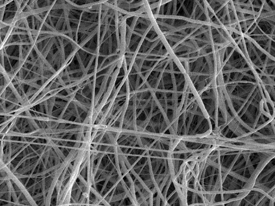
In-silico Development- and Clinical-Trial-Platform for Testing in-situ Tissue Engineered Heart Valves
- SimInSitu -
SimInSitu is aiming to develop a sophisticated in-silico method to predict the short- and long-term behavior of in-situ tissue engineered heart valves (TEHV) by combing advanced tissue remodeling algorithms with a personalized virtual heart modelling approach. The method will be specifically developed to predict the complex transformation process of biodegradable heart valves from the initially synthetic scaffold into a fully remodeled & functional valve.
Though, significant progress was made during the past years in developing TEHV based devices, it remains very challenging, costly, time-consuming, and rich with obstacles. New knowledge can only be generated through a tedious trial & error process (requiring preclinical and clinical studies), since the restorative process cannot be replicated in an in-vitro environment.
Advanced Computer Modelling & Simulation technologies have the potential to overcome this limitation by allowing to test new designs, modified scaffold compositions, or other applications in a virtual patient-specific environment – in-silico. The availability of this computer model could contribute significantly to an acceleration of especially the ETR-device development and accelerate their translation into the clinic and market.
Objectives
Ambition
Workplan
SimInSitu aims to develop a validated in-silico method capable of predicting short- and long-term safety & performance of in-situ tissue engineered heart valve
Support the development of in-situ tissue-engineered heart valve devices by generating beyond state-of-the-art simulation capabilities:
- Digital-Twin technology to investigate the device behaviour in a virtual patient-specific environment
- apply hierarchical V&V / UQ methodology to establish credibility evidence
- incorporate advanced tissue-remodelling and growth algorithms to account for the ETR process.
SimInSitu will follow a traditional phase-based development plan, which will start with various initially independent work-packages and will converge towards the development of the in-silico platform. Each phase and work-package will have its own deliverables and milestones.
Newsletter

In-Silico Clinical Trial Completion and Credibility Assessment of the SimInSitu Platform
2025-12-11 13:30
2025-12-11 13:30

Key Milestone in Predicting Endogenous Tissue Restoration in Biodegradable Heart Valves
2025-03-24 17:24
2025-03-24 17:24

SimInSitu Advances Patient-Specific TAVI Model for Heart Valve Testing
2025-03-20 08:03
2025-03-20 08:03
SimInSitu Project: Advancing Dissemination and Expanding Scientific Impact
2024-12-28 09:05
2024-12-28 09:05

Advancing Patient-Specific Modeling for Heart Valve Testing – SimInSitu Project Update
2024-12-28 08:44
2024-12-28 08:44

Milestone #8: Verification and Validation of the Finite Element Model of the Third Heart Valve Successfully Ac
2024-10-10 09:08
2024-10-10 09:08

Fluid Structure Interaction for Simulation and Validation of Transcatheter Heart Valve
2024-06-04 08:25
2024-06-04 08:25

Milestone #15 successfully achieved through patient-specific modeling of tissue-engineered heart valves in you
2024-05-10 21:18
2024-05-10 21:18

Milestone #10 successfully accomplished with the patient-specific modeling of TAVI using the SAPIEN 3 Ultra de
2024-03-25 10:48
2024-03-25 10:48

New Approaches in Scaffold Material Analysis: Understanding Fatigue Behavior
2024-02-22 15:50
2024-02-22 15:50

Milestone #5 is reached successfully with the Sapien 3 TAVI Device FSI Model
2024-01-20 17:19
2024-01-20 17:19

Modelling the Growth and Remodeling (G&R) of the Endogenous Tissue Restoration (ETR) In Xeltis Biodegradable D
2023-12-13 09:45
2023-12-13 09:45

InnovaHeart 2024 - 6-7 February in Leuven
2023-12-06 08:05
2023-12-06 08:05


Patient-Specific In-Silico Modeling of TAVI Patients
2023-05-20 06:54
2023-05-20 06:54

Pulmunary Valve In-Silico Modeling
2023-02-16 13:45
2023-02-16 13:45

Milestone on the scaffold characterisation and uncertainty quantification of materials for in-situ tissue-engi
2022-10-10 20:08
2022-10-10 20:08

The constitutive model of the scaffold material developed by the TU Graz agrees well with mechanical tests per
2022-02-21 16:04
2022-02-21 16:04

VPH Institute and SimInSitu: a joint strategy for comunication and dissemination
2022-01-25 13:40
2022-01-25 13:40

Patient-Specific FSI Simulation of TAVI
2021-12-22 17:11
2021-12-22 17:11

This project has received funding from the European Union’s Horizon 2020 research and innovation programme under grant agreement No 101017523




